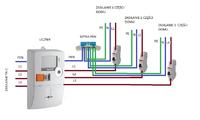Hello
I am going to connect the generator to the electrical system at home. I looked at the installation and tried to transfer it to the picture below. As of today, in the event of a power failure, I am forced to connect extension cords, tee, etc. Breaks in the supply of electricity to my town are quite common, and because it is surrounded by forests and with weather anomalies such as storms or freezing rain, it deprives us of electricity for up to two days. But the biggest problem is the defrosting freezer, the lack of lighting, and the time wasted on extension cords. In my house, the greatest demand for electricity is equipment such as a central heating pump, fridge-freezer and TV, all lighting on LED bulbs

The power generator I have is the AG2500 NUTOOL model
Maximum power of the generator - 2.2 kW
Nominal generator power - 2.0 kW
Start-Manual
Generator type - Synchronous
Number of phases Single-phase
Overload protection - Yes
Voltage stabilization -AVR
I checked a few topics on the electrode and decided to use a manual 3-phase cam switch. Please take a look at the picture below if I can connect it like this. Switch in position 1- electricity from the power grid, position 0-open circuit, position 2- electricity from a generator.

Thank you
I am going to connect the generator to the electrical system at home. I looked at the installation and tried to transfer it to the picture below. As of today, in the event of a power failure, I am forced to connect extension cords, tee, etc. Breaks in the supply of electricity to my town are quite common, and because it is surrounded by forests and with weather anomalies such as storms or freezing rain, it deprives us of electricity for up to two days. But the biggest problem is the defrosting freezer, the lack of lighting, and the time wasted on extension cords. In my house, the greatest demand for electricity is equipment such as a central heating pump, fridge-freezer and TV, all lighting on LED bulbs

The power generator I have is the AG2500 NUTOOL model
Maximum power of the generator - 2.2 kW
Nominal generator power - 2.0 kW
Start-Manual
Generator type - Synchronous
Number of phases Single-phase
Overload protection - Yes
Voltage stabilization -AVR
I checked a few topics on the electrode and decided to use a manual 3-phase cam switch. Please take a look at the picture below if I can connect it like this. Switch in position 1- electricity from the power grid, position 0-open circuit, position 2- electricity from a generator.

Thank you



